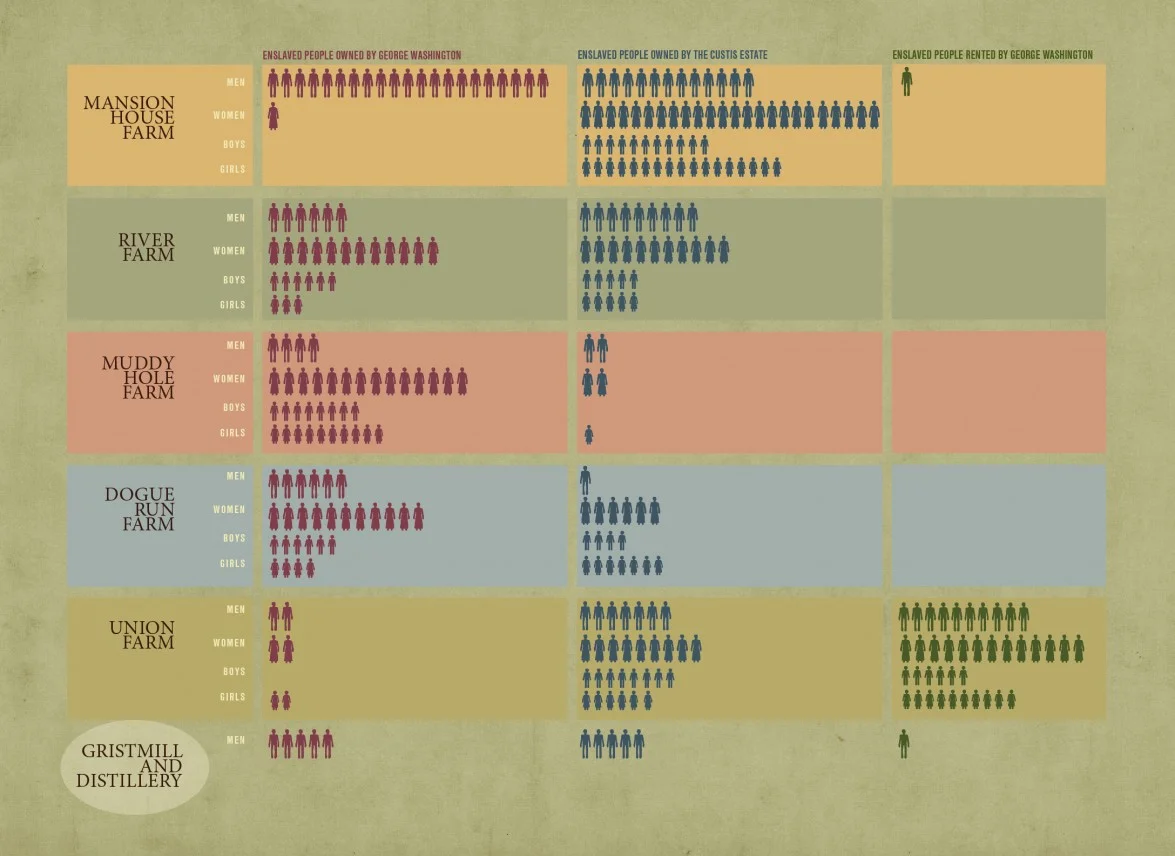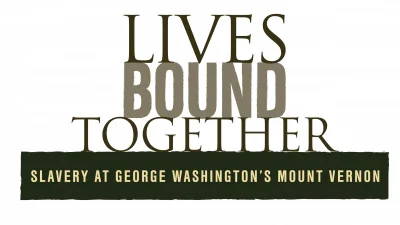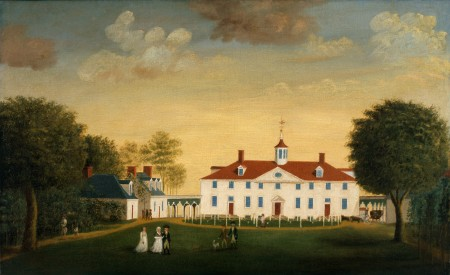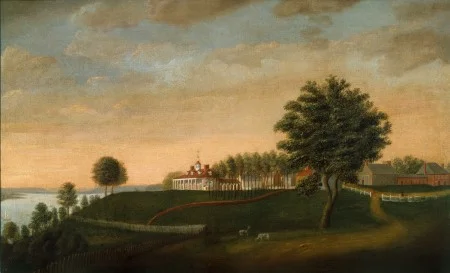Enslaved people spent most of their waking hours working without pay on Mount Vernon’s five farms.
Whether fieldhands, craftsmen, or household workers, they had little control over their schedules, work assignments, or living arrangements. George Washington expected them to “do their duty” by working diligently at all times. Those who did not meet his expectations faced punishment.
My people [must] be at their work as soon as it is light—work ’till it is dark—and be diligent while they are at it…
– George Washington, 1789
Yet enslaved men, women, and children persevered in the face of harsh physical and psychological conditions. They used subtle tactics to negotiate with Washington and overseers for better treatment. They acquired personal possessions to make their homes more comfortable. They grew vegetables and raised poultry to eat and sell. They practiced religion, played music, and told stories. They married, celebrated the births of children, and mourned loved ones who died. And they faced great risks to resist Washington’s authority, sometimes even running away.


Details of Edward Savage’s c. 1787-1792 painting, showing enslaved people near the Mount Vernon Mansion.
Population of the Five Farms
In 1799, Mount Vernon consisted of 8,000 acres divided into five farms, plus a gristmill and distillery. Enslaved men, women, and children lived on each farm, under the supervision of an overseer (usually a hired white man). The workers at Mansion House Farm were primarily domestic servants and craftsmen, while those on the outlying farms labored in the fields growing corn, wheat, and other crops.
This infographic shows how many enslaved adults and children lived on each farm—a total population of 317. Twenty of the “adults” were actually those between ages 11 and 14 who had already received a formal work assignment and were no longer considered children.

At Mount Vernon, many families were separated across different farms due to their work assignments.
Learn moreA Different View
Enslaved people experienced the Mount Vernon landscape very differently from the Washington family. George Washington obscured their homes and workspaces, planting trees and positioning walls to block the sights, sounds, and smells of labor from the Mansion and its surrounding area. Still, it was impossible to fully separate the elegant estate from the labor required to maintain it.
West Front of Mount Vernon
by Edward Savage, ca. 1787–1792
Edward Savage depicted the Washington family strolling on the expanse of lawn known as the bowling green. In the background, a group of enslaved men walks past the Servants’ Hall, while a woman walks across the circle in front of the Mansion. Enslaved people were a constant presence near the Mansion, whether performing work on landscape features or traveling from one part of the estate to another.
East Front of Mount Vernon
by Edward Savage, ca. 1787–1792
This view of the Mansion’s east front shows many of the landscape features that enslaved laborers added at Washington’s directive in the 1780s: the fenced deer park along the river, sunken brick “ha-ha” walls to keep livestock off the sloping lawn, and groves of trees obscuring the outbuildings beside the Mansion.
“There are a great number of Negro children at the Quarters belonging to the house people; but they have Always been forbid...within the Gates of the Inclosures of the Yards, Gardens, that they may not be breaking the Shrubs, and doing other mischief…”
– George Washington, 1793
The Landscape
George Washington designed Mount Vernon's landscape to be a beautiful pleasure ground for his family and guests. The labor of the estate’s enslaved people, along with a handful of hired workers, turned his vision of lawns, pathways, groves, and gardens into reality. Washington’s diary entries from 1785—the year he began a massive overhaul of his estate—reveal the extensive work necessary to alter the landscape.
The Vaughan Plan
In 1787, Samuel Vaughan completed this bird’s-eye view drawing of the Mount Vernon Mansion and its surrounding landscape, which Washington laid out in the 1780s.
“Continued with my jobbers to pound the Plaister of Paris as the Earth was too hard frozen to be dealt with.” – March 10, 1785
Washington experimented with plaster of Paris as a fertilizer for his lawns and gardens. Enslaved workers had to crush the hard substance into spreadable powder before it could be used.
“Began with James and Tom to work on my Park fencing.” – August 18, 1785
Washington’s carpenters constructed a park for tame deer near the Mansion. Enslaved people were skilled at building fences, which were necessary throughout the estate to keep livestock out of the fields.
“The ground being too wet, I employed the labourers who had been levelling the Lawn, in cleaning & weeding the Shrubberies.” – October 14, 1785
The lawns surrounding the Mansion were flattened by enslaved ditchers before gardeners planted them with grass. Moving the vast quantities of earth was grueling work, especially as the ground began to freeze.
“Set the People to taking up & planting small Pines in the Wilderness on the Right of the lawn.” – December 8, 1785
The far end of the bowling green on the Mansion’s west side featured groves of pine trees, which Washington called “Wildernesses.” His detailed plans for different varieties of trees near the Mansion required enslaved laborers to dig up trees elsewhere and transport them for replanting.
The Greenhouse - Slave Quarters
Washington’s greenhouse embodied his efforts to separate his visitors from the enslaved community. From the ornamental upper garden, white visitors could admire the brick greenhouse’s symmetry and tall windows, which allowed sunlight to warm the delicate tropical plants inside. They could not see that hidden in the building’s wings, accessible from the other side, were four barracks-style rooms where dozens of enslaved people lived.
Learn More
The content on this page was adapted from Lives Bound Together: Slavery at George Washington’s Mount Vernon, an exhibition on view from 2016–2020.
In 2025, Mount Vernon opened a reimagined version of the Lives Bound Together exhibition within the historic greenhouse quarters.


